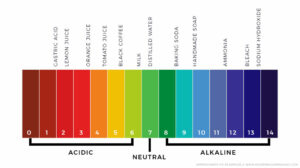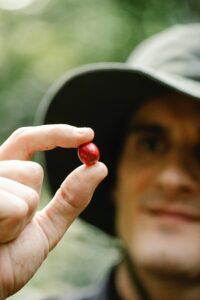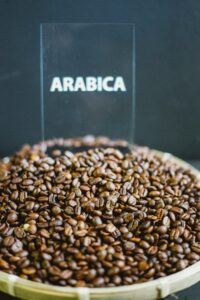Last updated on October 24th, 2023 at 21:00
Acid reflux is an inherent problem for some coffee lovers. The solution is to learn how to make coffee less acidic effortlessly and naturally.
It is easy, but it can be tricky as coffee has natural acids, many of which are good for your health. By the time you have finished reading this article, you will have a list of a number of things that you can do that will lower the acidity of your cup of coffee.
Some of which will be very surprising and raise an eyebrow or two.
Keep reading as we dig down and really detail the topic and help you to reduce the acidity of your coffee.
Let’s start with…
What Is The pH Level Of Coffee?
Table Of Contents
- 1 What Is The pH Level Of Coffee?
- 2 How To Make Coffee Less Acidic My Top 16 Tips
- 2.1 #1 Pay Attention To The Altitude And Soil
- 2.2 #2 Use Low-Acid Coffee Beans
- 2.3 #3 Try Different Coffee Growing Countries And Regions
- 2.4 #4 Use Arabica Coffee Beans
- 2.5 #5 Regulate The Temperature Of Your Water
- 2.6 #6 Avoid Keeping Your Coffee Hot For Too Long
- 2.7 #7 Roast Matters
- 2.8 #8 Brew Coffee With Hard Water Or Alkaline Water
- 2.9 #9 Focus On Your Extraction
- 2.10 #10 Add milk
- 2.11 #11 Use Eggshells
- 2.12 #12 Ditch Your Metal Mesh And Use A Paper Filter
- 2.13 #13 Get Salty
- 2.14 #14 Make A Cold Brew!
- 2.15 #15 Neutralize The Acidity With An Acid Reducer
- 2.16 #16 Add Baking Soda To Your Coffee
- 3 Does Butter Help To Reduce The Acidity In Coffee?
- 4 Does Cinnamon Reduce Acidity In Coffee?
- 5 Does Almond Milk Reduce The Acidity In Coffee?
- 6 Does Creamer Make Coffee Less Acidic?
- 7 Does Oat Milk Make Coffee Less Acidic?
- 8 Frequently Asked Questions About How To Make Coffee Less Acidic
- 8.1 How Do You Reduce Acidity In Coffee?
- 8.2 Does Salt In Coffee Reduce Acidity?
- 8.3 How Do You Make Coffee More Alkaline?
- 8.4 What Kind Of Coffee Is The Least Acidic?
- 8.5 Does Sugar Make Coffee Less Acidic?
- 8.6 What Neutralizes Acid In Coffee?
- 8.7 How Can I Reduce Acidity After Drinking Coffee?
- 8.8 Does Adding Milk To Coffee Reduce Acidity?
- 9 Frappé-Ing It All Up – How To Make Coffee Less Acidic
Acidity is measured using the pH scale. A pH of 7 is neutral; it is neither acidic nor alkaline. The lower the pH number is below 7, the more acidic it is. The higher the number is above 7 on the pH scale, up to a maximum of 14 are alkaline.
Coffee, on average, has a pH of 5. Some light roasts are in the pH range of 4.7.
Tomato juice and orange juice have a pH of 4 and 3, respectively.
Not all of the acids in coffee are bad for you and your health.
A fine example is Chlorogenic acid, which is found in very few sources outside of coffee and has a number of well-researched and peer-reviewed studies that indicate that it has a lot of beneficial properties for your health.
Chlorogenic acid is what gives coffee the bitter taste that coffee lovers may regard as coffee acidity. The longer a coffee bean is roasted, the more of this acid is broken down. This is one of the reasons why and how the roasting process plays a role in reducing coffee’s acidity. It is 100% true that dark roast coffee has acidity levels that are less than lighter roast profiles.
Quinic acid, something that is produced by coffee as it degrades, particularly when you are leaving that drip coffee on the hot plate to stew and get a bitter burnt flavor and give you an upset stomach. That is because of the Quinic acid.
This is why we encourage you to make fresh coffee.
Malic acid and phosphoric acid make your coffee taste sweeter. The Acetic acid and citric acid in low concentration add tartness and can produce a sour tasting coffee when they are extracted in excess.
The key to a great cup of coffee is getting a balance of the acidity and a balance of the bitter and sour notes.

Read: Sour espresso shot
How To Make Coffee Less Acidic My Top 16 Tips
Let’s get to the meat and bones of this article and talk about some very easy ways in which you can make your coffee less acidic.
Some of these tips are related to brewing, some to buying coffee beans and how to identify low-acid beans and which coffee roast is least acidic.
#1 Pay Attention To The Altitude And Soil
The greater the elevation the coffee beans are grown at, the greater the acidic levels are in the coffee beans. Volcanic coffee is great, tasty and rich in mineral content, unfortunately it also increases coffee acids.
This is where you have the advantage of buying your beans online.
You can simply check out the brand and beans, email the seller or search online for details about where they were grown. Any seller of quality coffee will have someone or some seller in the store that knows all about the beans and products they are selling and will be happy to show off their coffee knowledge to you.
Both in person and via email.

Read: Why does my coffee taste bitter?
#2 Use Low-Acid Coffee Beans
People are more health aware and there is an increasing demand for low-acid coffee beans. Most of these are produced in a manner that reduces the organic acids naturally and produces a good quality low acid bean. Other low acid coffee brands have compounds added to reduce the acid content.
Currently,
how each coffee brand processes their coffee beans for each of the different beans that they sell is unknown and seldom written on the label.
To reduce the acidity in coffee, some coffee brands remove the waxy upper layer of their beans prior to roasting. This also removes the acids in coffee beans and has little to no effect on the flavor but does make them less aromatic.
#3 Try Different Coffee Growing Countries And Regions
It is absolutely true that every coffee farm and co-operative produces a coffee with their very own unique flavor profile, even from within a country and region.
The differences from country to country are more pronounced than the subtle differences between the provinces within a country. The differences between coffee farms within the same province are even more subtle still. This is due to the difference in the climate and microclimate, soil quality and elevation.
Kenya, a great coffee producer, produces a more acidic coffee with fruity tones and notes. While coffee from the Indonesian Island of Sumatra and Brazil has a fuller body and less acidic compounds.
Be aware of how the coffee region can affect the acidity.

#4 Use Arabica Coffee Beans
Of the 4 different types of coffee beans, Arabica beans are by far less acidic than the others. Robusta is more acidic than Arabica, Excelsa and Liberica.
It is sufficed to say that a dark roasted Arabica bean is less acidic of all and a light roasted Robusta bean the most acidic.
#5 Regulate The Temperature Of Your Water
Your brewing temperature will affect the acidity of your coffee. The higher the temperature in which you are brewing, the more acidic it will be. The ideal temperature for brewing coffee is 92C to 96C (195F to 205F).
The lower you are on this brewing scale, the less acidic your coffee will be. The hotter water yields a higher extraction of coffee solids into your cup of coffee. More of the high temperature compounds and oils is good, but it also means a more acidic brew.
Extreme temperatures – either side of the ideal brewing temperature is not a good idea unless you are making cold brew coffee.
#6 Avoid Keeping Your Coffee Hot For Too Long
As we touched on earlier, avoid keeping your coffee hot if you can. Re-heating your coffee or keeping it in a thermos, thermal flask or even keeping a pot of coffee warm on the hot plate starts to produce Quinic acid, which gives coffee that stewed and acidic taste, increasing its acidity.
Letting your coffee cool and storing it in the fridge is fine.
#7 Roast Matters
Light roasts and medium roasts are more acidic than other roast profiles. If you see a coffee describing their flavor profile as having a bright or citrus fruit. These characteristics are from malic acid, which produces an acidic coffee.
The darker the roast, the less acidic they will be.

#8 Brew Coffee With Hard Water Or Alkaline Water
Water is by far the largest and most important ingredient in your coffee. As I have said many times all over on this website, the better the quality of your water is, the better your coffee will be.
Hard water is less acidic than soft water as it contains calcium, a compound that can neutralize the acids from the coffee.
Also, soft water has a little sodium content, which can have the effect of increasing the acidity in the coffee.
It stands to logic and reason that using alkaline water or hard water you can tone down the acid in coffee.
#9 Focus On Your Extraction
A high level of acidity is often a symptom related to an under-extracted coffee. There could be a number of reasons for this, including your brew time being too short, your grind size too large and too coarse.
It can also be related to a particular brewing method. Channelling of your coffee puck, for example, can lead to a poor extraction and an acidic taste.
This is why, at Latte Love Brew we encourage you to be scientific and geeky, like a nutty professor when brewing coffee. Take notes, be precise, use a digital coffee scale to weight everything and measure the temperature and time you extraction.
Great, world-class coffee every single time is the reward for such precision.
Focus on your extraction, and you can reduce the natural acids in your coffee.
#10 Add milk
A very simple step here in reducing the acidity in your finished brew is to just add cream or milk. They both help to balance the pH level.
This works better for darker roasts as light roasted beans do not go so well with milk. Be careful with non-dairy milk like soy milk, as acidic coffee will make it curdle.

#11 Use Eggshells
I bet this sounds like a joke, it is not. The use of eggshells in coffee brewing dates back centuries and to the old-fashioned Cowboy coffee brewing method.
Eggshells are alkaline, and that means they will help you to neutralize the acidity in coffee and may even aid in smoothing out any over-extracted bitter flavors.
#12 Ditch Your Metal Mesh And Use A Paper Filter
If your brewing with a method that needs a filter, you can switch out your metal mesh filter or cover that stainless steel filter coffee basket with a paper filter.
A paper filter filters out all the coffee oils and other compounds that may contribute to the coffee acidity.
If you are drip brewing, or using the siphon or pour over method or even percolator coffee you can think about this simple step of using a paper filter to obtain a reduction in the acid in coffee with literally no extra effort on your part.

#13 Get Salty
Adding salt to coffee helps to reduce the acidity. But use only a touch of salt, I mean a dash to your grounds before you brew your cup of coffee.
The bonus is you will get a rounder flavor as salt has the additional effect of reducing any bitter notes and tones, and you end up with a great Cuppa of Joe.
Be careful not to overdo it.
Coffee Fact: In Vietnam, salt coffee is a commonly asked for drink on the drink menu in many independent coffee shops. Traditionally, salt was used to freshen up older bitter coffee beans!
#14 Make A Cold Brew!
Cold brew coffee extracts all the low temperature coffee compounds and, by brewing with cold water and brewing in your fridge, you will enjoy a coffee that is 60% less acidic. Cold brewing in your fridge will get better results.
#15 Neutralize The Acidity With An Acid Reducer
Coffee is a drink that is naturally acidic. A simple way of lowering the acidity is to neutralize it with an acid reducer.
An acid reducer is something that simply produces a reaction and lowers the acidity of your coffee. Most coffee shops or stores will sell something that you can use to make your coffee more alkaline. The bonus is they are not expensive and don’t have an effect on the flavor profile.
A good acid reducer can reduce the acidity by up to 90%. Personally, I prefer not to use them as there are plenty of alternatives that you can use, like salt, eggshells, baking soda or any of the techniques we have spoken about already.
#16 Add Baking Soda To Your Coffee
Adding baking soda to coffee does not alter the flavor. It has a pH of 9, which helps to neutralize the coffee acids, making it less acidic. Just a teaspoon is enough.
Does Butter Help To Reduce The Acidity In Coffee?
No,
coffee with butter added to it has not been proven to reduce the natural acidity of coffee. The consumption of butter in coffee may have some health benefits when used in small quantities as it increases healthy bacteria in your stomach.
Butter has an acidity that ranges from a pH of 6.1 – 6.4 which is acidic.
The fat content of butter puts many off using it in their coffee.

Does Cinnamon Reduce Acidity In Coffee?
Not really. Read on to find out why!
Cinnamon is a natural antacid that has antioxidant and anti-inflammatory properties. You have two options for how you use cinnamon to neutralize the acidity of your coffee. You can grind a cinnamon roll down and sprinkle it into your coffee grounds and brew with it that way.
Or you can add soluble cinnamon to your coffee once it has been brewed. The first way is more effective at extracting flavor and lowering the acidic taste.
Although cinnamon is an antacid, it has not been proven in studies to reduce acidity, just the perception and acidic taste. The pH did not change.
In fact, using too much cinnamon has the potential to increase the acidity.
Does Almond Milk Reduce The Acidity In Coffee?
Almond milk is a great non-dairy milk product that can help you to reduce the acidity levels of your cup of coffee. If you are allergic to dairy products or milk, it is a great option as it is alkaline and aids in neutralizing your stomach acid and helps with acid reflux symptoms.
Almond milk works great in all kinds of coffee, including hot coffee, cold-brewed coffee, iced coffee and especially lattes. The nutty flavor really works well with a wide range of coffee drinks.
Does Creamer Make Coffee Less Acidic?
Yes,
adding milk or cream is one of the easiest ways of reducing the acidity levels of your coffee. Most coffee fans and coffee enthusiasts do it without realizing it has this effect. The calcium in the cream (or milk) is what helps to make your coffee less acidic.
The calcium in these components helps balance the coffee’s pH, making it less acidic.
Does Oat Milk Make Coffee Less Acidic?
Oat milk is acid forming, and thus it is not something that you should add to your coffee in an attempt to neutralize acidic coffee. It should be avoided if you suffer from GERD or acid reflux.
Even though the small amount of calcium may help, the fact that it is acid forming negates its use for the purpose of neutralizing acidic coffee.

Frequently Asked Questions About How To Make Coffee Less Acidic
How Do You Reduce Acidity In Coffee?
Here are some top ways of reducing the acidity in your coffee that are effortless.
- 1. Add a dash of baking soda. It does not affect the flavor.
- 2. Opt for darker roasts than light roasts.
- 3. Use a coarser grind.
- 4. Brew at a slightly lower temperature.
- 5. Increase the brewing time.
- 6. Drink cold brewed coffee – it’s naturally less acidic.
Does Salt In Coffee Reduce Acidity?
Yes,
salt is something that you can use to reduce the acidity in your coffee. It seems to be like a joke to tell someone to add salt to their coffee. The effect is a coffee that is less acidic. Salt is more commonly used to take the edge off of an overtly bitter coffee. Adding salt to reduce the acidity may reduce acid reflux.
How Do You Make Coffee More Alkaline?
You can switch your beans to a darker roast and instantly make your coffee more alkaline. A light roast is more acidic and this changing the roast is one simple step. You can also add just a pinch of salt, a little baking soda, a water alkalizer or coffee tamer to make your cup of coffee more alkaline.
What Kind Of Coffee Is The Least Acidic?
A dark roast is less acidic than medium and light roasts. Dark roasts are roasted at a higher temperature and for a little longer than the other two roasts. The roasting process loses a lot of the acids in the coffee.
Does Sugar Make Coffee Less Acidic?
Yes,
adding sugar to your coffee has the effect of reducing the acidity of coffee just a little bit. Sugar is not as effective as other acid reducers like bicarbonate of soda (baking soda) in making low-acid coffee.
What Neutralizes Acid In Coffee?
There are a lot of items that reduce the acidity of your coffee. These range from salt, to baking soda, calcium, eggshells and more.
Even adding milk or cream can have.
How Can I Reduce Acidity After Drinking Coffee?
You can try to counter the acidity of your coffee by eating or drinking something that is alkaline or taking an antacid tablet.
Does Adding Milk To Coffee Reduce Acidity?
Yes, the calcium in your milk will help to reduce the acidity of your coffee beverage, not a lot, but it will reduce it a little.
Frappé-Ing It All Up – How To Make Coffee Less Acidic
If you have read this far, you know exactly how to make coffee less acidic with 16 easy hacks that you can use with little to no effort on your part.
If you have scrolled and skimmed down – you have missed out on some easy tips to make your coffee more alkaline. A quick brief – focus on your beans, where they are from, their elevation, roast and your brewing technique, as these all play their part.
There are also some items you can add to your coffee to reduce its acidity with the most common ones being milk, cream, salt (yes salt!) and baking soda.
Join our cool coffee community and tell us all about the tasty new beans that you are trying out. Find us on Facebook/Meta.






![[Recipe] How To Make Dunkin Iced Coffee At Home Like A Pro!](https://lattelovebrew.com/wp-content/uploads/2022/04/Recipe-How-To-Make-Dunkin-Iced-Coffee-At-Home-Like-A-Pro-1024x576.jpg)
